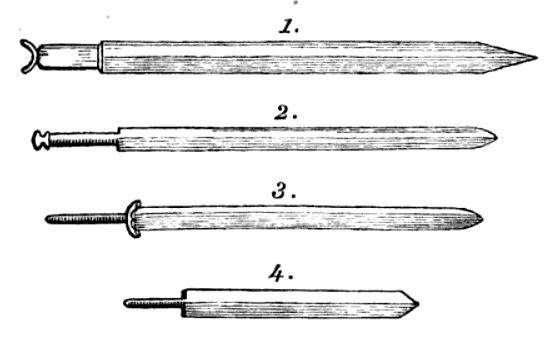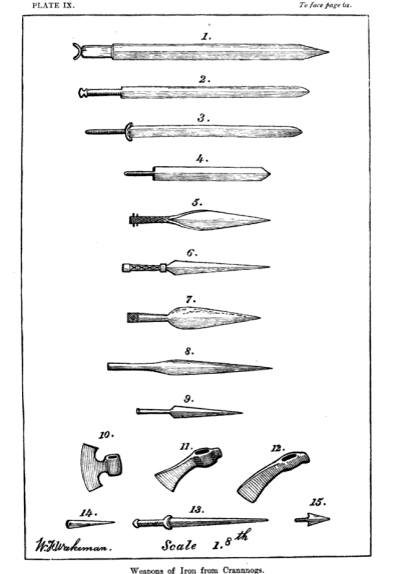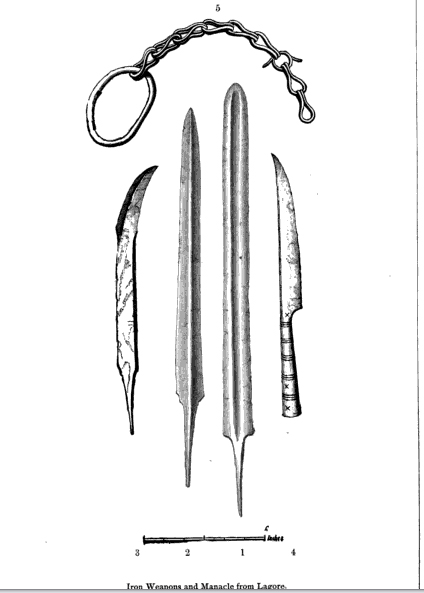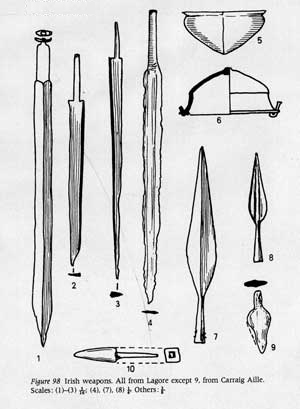| Author |
Message |
David Huggins

|
 Posted: Mon 30 Mar, 2009 11:03 am Post subject: 6th/7th Century Irish swords info? Posted: Mon 30 Mar, 2009 11:03 am Post subject: 6th/7th Century Irish swords info? |
 |
|
Hi Guys
Can any one help with any information on 6th/7th century Irish swords?
cheers
Dave
and he who stands and sheds blood with us, shall be as a brother.
|
|
   |
 |
Jared Smith

|
 Posted: Tue 31 Mar, 2009 7:09 pm Post subject: Posted: Tue 31 Mar, 2009 7:09 pm Post subject: |
 |
|
You should try looking under Pictish and Gaelic swords, as appropriate to the region and people of that location and era. Several texts can be previewed for free showing the same basic form of sword from around 4th to 8th century. Ownership of a sword in that region and era is considered uncommon. There are a couple of examples surviving, but I have not had any luck finding a museum photo or stats for you. In appearance they are basically generic migration era style with only a flat bar portion of pommel remaining (similar to Peterson types O and P, although I doubt there is much taper to the blades of 6th and 7th century.) Consensus seems to be that most pre-viking era blades in that region were short. I will keep looking for something more detailed.
Absence of evidence is not necessarily evidence of absence!
|
|
  |
 |
|
Jeroen Zuiderwijk
Industry Professional
|
|
   |
 |
David Huggins

|
 Posted: Thu 02 Apr, 2009 2:16 am Post subject: Irish 6th/7th Century swords Posted: Thu 02 Apr, 2009 2:16 am Post subject: Irish 6th/7th Century swords |
 |
|
Hi Jared/Joroen,
Thanks for the replies on this call for information which I put out on behalf of a friend who wishes to recreate a Irish raider of the period (?Scotti) .
There is some limited information on swords in the Osprey publications, 'Pictish Warrior' and 'Arthur and the Anglo-Saxon Wars' and interestingly Jeroen some are line drawings of the swords you have posted. I think it said they may have been some Moorish influence on these swords!! Perhaps not so outlandish when you look at the various cultural influences in the manuscript artwork of the Irish Clergy of the same period. Thanks again.
ta
Dave
and he who stands and sheds blood with us, shall be as a brother.
|
|
   |
 |
Bruno Giordan

|
 Posted: Thu 02 Apr, 2009 2:34 am Post subject: Posted: Thu 02 Apr, 2009 2:34 am Post subject: |
 |
|
The thick tang I have seen also in a couple of langbardian swords who are devoid of pommel and cross.
Interestingly enough such blade has a decorated tang meaning that there was no organic matter covering it: it was used bare it seems.
|
|
  |
 |
David McElrea

|
 Posted: Thu 02 Apr, 2009 11:00 am Post subject: Posted: Thu 02 Apr, 2009 11:00 am Post subject: |
 |
|
|
I'm not so sure about that, Bruno. If I recall correctly, there are a number of finds that sport decoration in places where it would never be seen. That might be the case here, too. Looking at it I just can't imagine it being practical without hilt components. The decorations are interesting, for sure, though. Anyone else have any thoughts?
|
|
  |
 |
Jared Smith

|
 Posted: Thu 02 Apr, 2009 4:25 pm Post subject: Posted: Thu 02 Apr, 2009 4:25 pm Post subject: |
 |
|
Short broad choppers (Roman era description, Tacitus) were described as having a very blunt rounded point in the 1st century A.D.. I suspect the photo example above is more representative of something prior to your stated 6th to 7th century period.
There is a narrow window around 6th to 7th century A.D. when Anglo-Saxon blades likely native to the region were probably not of Viking import/origin nor of a curved shape influenced by Moors.
Absence of evidence is not necessarily evidence of absence!
|
|
  |
 |
Matt Easton

Location: Surrey, UK. Joined: 30 Jun 2004
Posts: 241
|
 Posted: Fri 03 Apr, 2009 4:33 am Post subject: Posted: Fri 03 Apr, 2009 4:33 am Post subject: |
 |
|
Moorish swords of that time were straight and double-edged. But I find it very unlikely there was any Moorish influence on Irish weapons, even though there is some (ceramic) evidence for trade with Spain and North Africa. To me the Irish swords seem like a kind of survival of the Gladius. Ireland was a bit isolated of course. I wonder how many examples of these odd swords have actually been found?
Matt
Schola Gladiatoria - www.swordfightinglondon.com
YouTube: www.youtube.com/user/scholagladiatoria
Antique Swords: www.antique-swords.co.uk/
|
|
    |
 |
David McElrea

|
 Posted: Fri 03 Apr, 2009 12:36 pm Post subject: Posted: Fri 03 Apr, 2009 12:36 pm Post subject: |
 |
|
Here are some images of swords (and other weapons) found at the crannog (fortified man-made island) at Lagore, Co. Meath, Ireland. They are estimated to be of 7th-10th century provenance and typify the native Irish work over and against the Viking imports that became the staple of later Irish warfare. The blade lengths of these swords averages around 18 inches.
One image is a close up of the swords from another (as will be evident enough).
Note, as well that the hilts of some are only partially present... even those that seem more complete are missing organic components that would have changed the overall appearance of the sword.
Hope this helps.
 Attachment: 75.16 KB Attachment: 75.16 KB

 Attachment: 86.06 KB Attachment: 86.06 KB

 Attachment: 79.19 KB Attachment: 79.19 KB

|
|
  |
 |
David McElrea

|
 Posted: Fri 03 Apr, 2009 12:50 pm Post subject: Posted: Fri 03 Apr, 2009 12:50 pm Post subject: |
 |
|
A further note and a question or two:
Note: Although it is not clear in the above picture one of the spearheads appears to be tanged (no. 6 above), which is unusual for this era. You can see where two ferrules rest over the tanged section of the blade, which is also decorated. I could be wrong, of course, as these are artist's renderings rather than photos...
Question: I am fascinated by the socketed blade on the right-hand side of the bottom picture. It is described as a socketed "knife" and it certainly appears knife-like, but why would one go to the trouble of forming a socket unless one was going to affix the blade to something which would seem to be unneccessary given the apparent length of the blade?
Are there other examples of socketed knives from iron-age/migration contexts?
Could we be looking at an unusually shaped spearhead?
It's a beauty, either way.
|
|
  |
 |
David McElrea

|
 Posted: Fri 03 Apr, 2009 1:17 pm Post subject: Posted: Fri 03 Apr, 2009 1:17 pm Post subject: |
 |
|
Some more images from Lagore and related finds. The bottom pick contains an artistic rendering of the British Museum piece that Jeroen has posted above:
 Attachment: 65.33 KB Attachment: 65.33 KB

 Attachment: 127.46 KB Attachment: 127.46 KB
[ Download ]
|
|
  |
 |
|
Jeroen Zuiderwijk
Industry Professional
|
 Posted: Fri 03 Apr, 2009 4:12 pm Post subject: Posted: Fri 03 Apr, 2009 4:12 pm Post subject: |
 |
|
| David McElrea wrote: | | Some more images from Lagore and related finds. The bottom pick contains an artistic rendering of the British Museum piece that Jeroen has posted above: |
Hey, there's the swords with expanding blades, so I wasn't dreaming it  I recall having seen much more extreme expanding blades as well. B.t.w. here's what looks like no.2 from the swords at the top drawing: I recall having seen much more extreme expanding blades as well. B.t.w. here's what looks like no.2 from the swords at the top drawing:

It's in the Roskilde Vikingship Museum, and described as an Irish Viking period sword.
Jeroen Zuiderwijk
- Bronze age living history in the Netherlands
- Barbarian metalworking
- Museum photos
- Zip-file with information about saxes
|
|
   |
 |
David McElrea

|
 Posted: Fri 03 Apr, 2009 4:15 pm Post subject: Posted: Fri 03 Apr, 2009 4:15 pm Post subject: |
 |
|
|
Jeroen, I can't tell you how long I've been wanting to see one of those swords in "real life." Thank you so much for posting that. I had no idea it was in the Netherlands now.
|
|
  |
 |
Jared Smith

|
 Posted: Fri 03 Apr, 2009 5:30 pm Post subject: Posted: Fri 03 Apr, 2009 5:30 pm Post subject: |
 |
|
I also thank you for posting the artist's illustrations and the museum photo. I figured that anything "close" to viking era probably has been snapped up and deemed "viking"! For this post, the difference would be very blurred anyway as Scandinavian - Germanic connections with Gaelic in the Scottish - Ireland area probably occurred regularly by then.
Absence of evidence is not necessarily evidence of absence!
|
|
  |
 |
|
Jeroen Zuiderwijk
Industry Professional
|
|
   |
 |
Dan Dickinson
Industry Professional

|
 Posted: Sun 05 Apr, 2009 11:53 am Post subject: Posted: Sun 05 Apr, 2009 11:53 am Post subject: |
 |
|
Jeroen,
From the drawings I had seen, I had thought that the triangular portion at the shoulders of the first blade you posted was a result of grinding....however, looking at your photos, it looks almost like a ferrule that extends into a triangular langlet. Having seen it in person could you clear up which one it is?
Thanks,
Dan
|
|
  |
 |
|
Jeroen Zuiderwijk
Industry Professional
|
 Posted: Sun 05 Apr, 2009 3:24 pm Post subject: Posted: Sun 05 Apr, 2009 3:24 pm Post subject: |
 |
|
| Dan Dickinson wrote: | Jeroen,
From the drawings I had seen, I had thought that the triangular portion at the shoulders of the first blade you posted was a result of grinding....however, looking at your photos, it looks almost like a ferrule that extends into a triangular langlet. Having seen it in person could you clear up which one it is?
Thanks,
Dan |
I thought it was forged in one piece, but now that you mention it, it may be a ferrule with langlet. So I can't give any confirmation either way I'm afraid.
Jeroen Zuiderwijk
- Bronze age living history in the Netherlands
- Barbarian metalworking
- Museum photos
- Zip-file with information about saxes
|
|
   |
 |
Matt Easton

Location: Surrey, UK. Joined: 30 Jun 2004
Posts: 241
|
|
    |
 |
|
Stephen Curtin
|
 Posted: Mon 06 Apr, 2009 11:39 am Post subject: Posted: Mon 06 Apr, 2009 11:39 am Post subject: |
 |
|
Hey guys, just thought id jump in here to say great thread, especially the pics. I have heard of these swords a long time ago but never got the chance to see any. I also would like to recommend a book on the subject for anyone interested, Weapons and Warfare in Viking and Medieval Dublin which can be bought at the dublin museum website. Glad to see more people interested in Irish swords, keep up the good work guys.
Éirinn go Brách
|
|
   |
 |
Elling Polden

|
 Posted: Mon 06 Apr, 2009 4:58 pm Post subject: Posted: Mon 06 Apr, 2009 4:58 pm Post subject: |
 |
|
Any clue on how the organic components looked? Did these swords have wooden pommels, like a roman spatha?
Further, how do they come out weight-wise? How does the diamond-section swords compare to the deeply fullered viking blades?
"this [fight] looks curious, almost like a game. See, they are looking around them before they fall, to find a dry spot to fall on, or they are falling on their shields. Can you see blood on their cloths and weapons? No. This must be trickery."
-Reidar Sendeman, from King Sverre's Saga, 1201
|
|
    |
 |
|
|

